
How Many KWs Does Your Sauna Heater Use?
|
Time to read 9 min
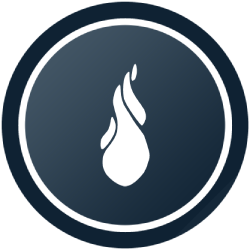
|
Time to read 9 min
In the coming winter, a large part of the world will be looking at the price of energy with greater consideration than in previous years. Many may think that the sauna is one of the things to compromise on to save electricity, but we encourage you to take a closer look at the energy consumption of the sauna, as the equation is affected by several variables: the desired temperature, the time of the sauna, the materials used in the sauna, the ratio between the power of the heater and the volume of the sauna, the operation of ventilation and so on...
With a few simple tips, you can significantly reduce your energy consumption in the sauna. In addition, you should remember that most of the heat from the sauna remains in the house.
When considering the energy consumption of a sauna, it is useful to recall one of the basic laws of chemistry and physics about the conservation of energy. Energy cannot be created or destroyed, it can only be changed or transferred from one form to another.
Electricity generators convert all electricity into heat. The heating thermostat regulates the heating elements on and off to keep the unit warm at the desired temperature.
During the heating of the sauna and sauna bath, the heater heats not only the air, but also the stones, wall and ceiling panels, doors and sauna benches. Most of the heat from the sauna room is transferred through the door and the structure to the rest of the building. The heat energy that leaks from the sauna to the rest of the home, for example to the adjacent bathroom, reduces the need for other sources of heat. The sauna can therefore be considered as a secondary source of heat during the colder months. If a ventilation heat recovery system or an exhaust air heat pump is used, most of the heat from the ventilation remains useful for heating the building.
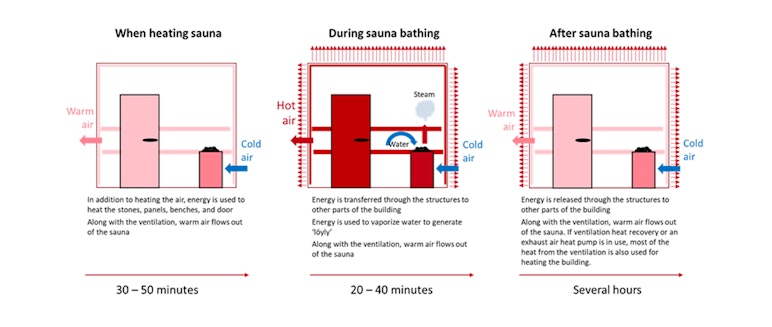
The heater's kW power x uptime does not directly indicate the kilowatt hours spent on sauna bathing. After reaching the sauna room's target temperature, the heater's thermostat starts to cut off the electricity going to the heater's heating elements. In the heating phase, the heater is turned on at full capacity for the first 30–40 minutes, depending on the size of the sauna, insulation, and the adjusted temperature. After that, the power is about 50% of the maximum so that the sauna room remains at the desired temperature.
Take, for example, a traditional Finnish family sauna for 3-4 people with a 6-kWh sauna heater. Typically, the sauna is initially heated for about an hour, after which the stove is still on for another hour. In this case, a 6-kilowatt heater consumes 4-5 kilowatt hours in the first hour and 3-4 kilowatt hours in the next hour. In total, the consumption of the heater in two hours is about 7-9 kilowatt hours. The consumption figures are based on an insulated sauna with a heater suitable for the sauna room’s size.
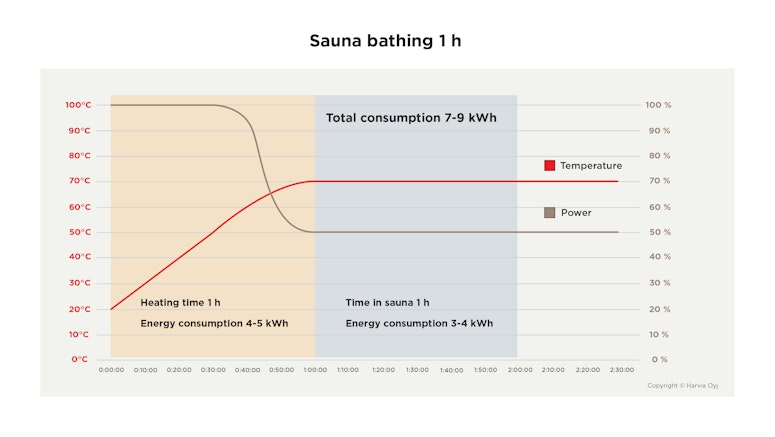
By investing in sauna practices, energy can be saved at best a few kilowatt hours if you go to the sauna as soon as it is ready and only go to the sauna for 15–20 minutes, which is enough to take advantage of the health effects of heat. On an annual basis, the savings can be more than 500 kilowatt-hours if you go to the sauna three times a week. If the heater is kept on for two hours at a time and the sauna is used 3 times a week, the annual consumption of the example sauna above is 1092–1404 kWh. When you follow the smarter way of going to the sauna as shown in the figure below, the consumption is well under a thousand kilowatt-hours (780 kWh). So, it's worth investing in smart sauna practices.
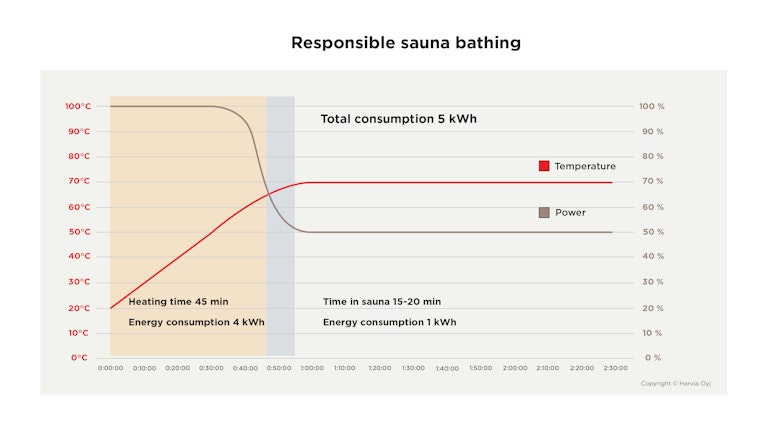
The effect of sauna heating on the electricity bill depends on the type of heating system and living mode. If the apartment has a fixed electricity contract in use, going to the sauna in a home with direct electric heating does not cause additional costs during the colder months when heating of homes is needed. Most of the heat in the sauna remains inside the building. If night or stock exchange electricity is used, the difference in electricity price between the moment the heating system is heated and the sauna is heated. In homes heated with district heating, wood, or a heat pump, the effect of sauna on the electricity bill naturally depends on the costs of different heating methods compared to the price of electricity, but it can be said that sauna always has a lowering effect on the total amount of energy consumption.
In housing cooperatives, heating is typically included in the maintenance charge, and the heating of the sauna has a direct impact on the electricity bill. But on the other hand, bathrooms are often heated with underfloor heating, the need for which is reduced thanks to sauna bathing. And naturally, the effect of sauna heating is visible with a delay in the maintenance charge.
When calculating the price of sauna bathing, no general calculation formula can be used. If we do not consider the heat that remains in the apartment for use, we can say that the cost of sauna bathing is a few dollars per sauna session. If you divide the amount by the number of sauna bathers, the price is quite small compared to the beneficial effects of sauna bathing.
Re-stack the stones at least once a year and, if necessary, replace the old stones with new ones
Replacing and stacking the stones again is one of the most effective maintenance tips to save energy. When the air can circulate correctly in the heater, the sauna heats up faster and the heater consumes less energy to heat up the sauna room.
It is highly recommended to rearrange the stones at least once a year or more often if the sauna is used a lot. Heater stones break down slowly but gradually during use due to large temperature fluctuations. At the same time, any pieces of stone are removed from the bottom of the heater and the broken stones are replaced with new ones. In this way, the heating capacity of the heater remains optimal, and the risk of overheating is avoided. You should check the stone stacking instructions in the user manual of your own heater.
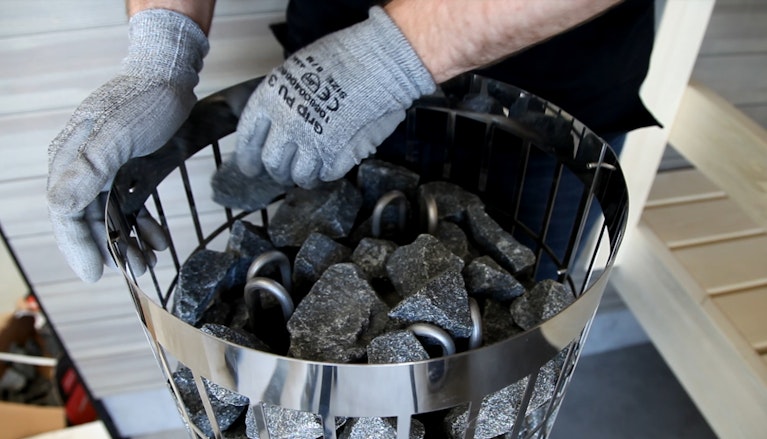
Set the heater to a lower temperature - good steaming is often achieved at 70°C (158°F)
The most important thing is to choose a heater according to your own sauna preferences. My view is that a sauna bather who has a pillar heater with a large number of stones is often more satisfied with the lower temperature. The large mass of stones provides nice soft steam. In heaters with a larger stone capacity, such as Harvia Legend, Cilindro, and Glow heaters, the stones retain and give off their heat even longer after the heater has been turned off.
The airy stacking of the stones and the stones in good condition also improve the ‘löyly’ experience and speed up the warming of the sauna room, as the warm air transfers to the sauna room better.
For those who like a higher temperature, I recommend heaters with a smaller stone mass, good examples of which are the Harvia Virta and the Wall heaters.
Make sure that you have a heater with the right power in use
One important thing is to select the heater's power according to the volume of the sauna room and the materials used. If the heater is too powerful for the volume of the sauna, it may heat up the sauna room quickly, but it will not give the stones enough time to store enough heat to throw ‘löyly’, the steam. In this case, the re-warming of the stones will require more time. If the heater is too small for the volume of the sauna room, it may take too long to reach the desired temperature, and the heating elements may wear out faster due to overuse. A longer heating time also means a longer time for energy to move away from the sauna room, even though a large part of the heat goes elsewhere in the apartment.
Check that the ventilation in the sauna is adjusted correctly
All saunas need some ventilation system to exchange/cycle the air in the sauna. When no one is using the sauna, and there is no source of moisture, ventilation is not necessary. If you have the option, keep vents closed when the sauna is heating. Doing so helps retain the heat in your sauna and allows it to reach the desired temperature faster. When entering the sauna and throwing löyly (steam), it is necessary to open the vents for fresh air. Too much ventilation may mean that the heat escapes the sauna too soon. Too little ventilation may make the air difficult to breathe. Also, the lack of ventilation makes drying the sauna difficult.
Avoid unnecessary heating of the sauna and shorten the sauna time
Go to the sauna as soon as it reaches the desired temperature and turn off the sauna immediately after the sauna bathing. To achieve the health benefits of the sauna, 15 minutes is enough.
Do not keep the door open for any unnecessary amount of time
When the sauna door is opened, heat escapes from it to the rest of the apartment. It is not worth opening the door unnecessarily. After going to the sauna, you can leave the sauna door open, in which case the heat will be transferred to the bathroom and dry as well.
All these tips apply equally in wood-heated saunas and save nature.
I think we need to focus on reducing our daily energy consumption. Lowering the temperature of the home by, for example, a degree and reducing the consumption of hot water has a more significant effect on energy consumption than taking a sauna. One of my findings is also that sauna use can actually reduce the use of hot water as well, as the need for hot showers is reduced. Heating the shower water typically consumes a lot of energy in the home, and all the warm water goes down the drain and its heat cannot be utilized, unlike the heat of the sauna.
In addition to the adjusted indoor temperature, I focus on those appliances where energy is directly going out of the house and cannot be further utilized. In addition, to reduce the amount of warm water flowing down the drain, I also pay attention to the timely use of the cooker hood that blows warm air directly out of the house, i.e. I don't forget to turn off the cooker hood after cooking. The doors are not kept open unnecessarily, and I have paid attention to the condition of the door and window seals. In addition, I have looked critically at outdoor lighting and Christmas lights, because their energy goes directly outside. I'm not so worried about the use of electrical appliances whose energy remains to be utilized. The same laws apply to them as to a sauna heater, meaning that the heat remains for use. These include, for example, the oven and the lamps inside. Of course, I make sure that no device is on unnecessarily.
In addition, I recommend checking all electrical appliances in the home to make sure they are in proper working order. Maintenance of appliances such as refrigerators and freezers can significantly affect their energy consumption. Even small actions can affect daily energy consumption.
Investing in the energy efficiency of sauna bathing serves both the wallet and the environment but is also a wise investment in maintaining one's own health and well-being. Sauna bathing has several scientifically proven health benefits. Regular sauna bathing supports a lifestyle that promotes health and well-being. The sauna offers relaxing moments that are precious in today's stressful world situation. But above all, going to the sauna is enjoyable!
#healingwithheat
— Timo Harvia , CTO, Harvia Group
Original text from Harvia.
https://www.harvia.com/en/ideas-and-trends/sustainability-and-safety/faq-about-the-energy-consumption-of-sauna-bathing/